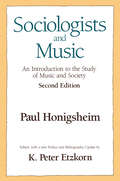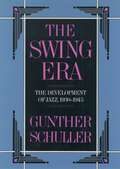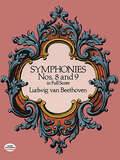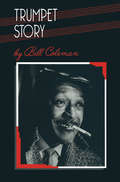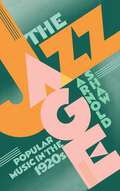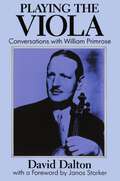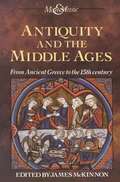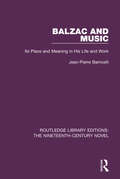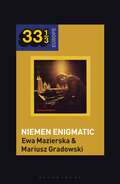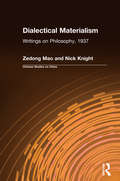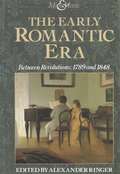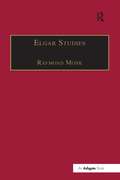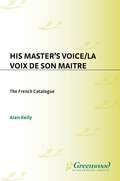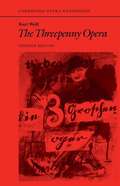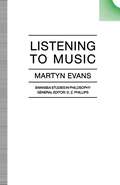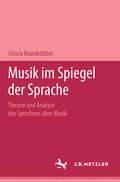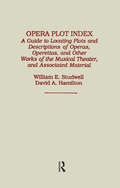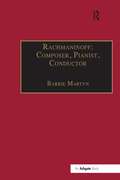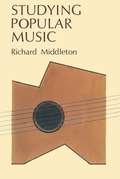- Table View
- List View
Sociologists and Music
by Paul HonigsheimSociologists have always been fascinated with music. In one way or another they have encountered music as an important social force in its own right, as an accompaniment or byproduct of phenomena they studied (such as youth culture or the drug scene), or as a means for obtaining social compliance (as in religious ceremonies or in the military). This book goes one step toward remedying this situation by culling the existing literature for building blocks toward introducing sociological synthesis and by presenting the English version of the extensive writings on music and society by Paul Honigsheim.
Sociologists and Music
by Paul HonigsheimSociologists have always been fascinated with music. In one way or another they have encountered music as an important social force in its own right, as an accompaniment or byproduct of phenomena they studied (such as youth culture or the drug scene), or as a means for obtaining social compliance (as in religious ceremonies or in the military). This book goes one step toward remedying this situation by culling the existing literature for building blocks toward introducing sociological synthesis and by presenting the English version of the extensive writings on music and society by Paul Honigsheim.
The Swing Era: The Development of Jazz, 1930-1945 (The History of Jazz)
by Gunther SchullerHere is the book jazz lovers have eagerly awaited, the second volume of Gunther Schuller's monumental The History of Jazz. When the first volume, Early Jazz, appeared two decades ago, it immediately established itself as one of the seminal works on American music. Nat Hentoff called it "a remarkable breakthrough in musical analysis of jazz," and Frank Conroy, in The New York Times Book Review, praised it as "definitive.... A remarkable book by any standard...unparalleled in the literature of jazz." It has been universally recognized as the basic musical analysis of jazz from its beginnings until 1933. The Swing Era focuses on that extraordinary period in American musical history--1933 to 1945--when jazz was synonymous with America's popular music, its social dances and musical entertainment. The book's thorough scholarship, critical perceptions, and great love and respect for jazz puts this well-remembered era of American music into new and revealing perspective. It examines how the arrangements of Fletcher Henderson and Eddie Sauter--whom Schuller equates with Richard Strauss as "a master of harmonic modulation"--contributed to Benny Goodman's finest work...how Duke Ellington used the highly individualistic trombone trio of Joe "Tricky Sam" Nanton, Juan Tizol, and Lawrence Brown to enrich his elegant compositions...how Billie Holiday developed her horn-like instrumental approach to singing...and how the seminal compositions and arrangements of the long-forgotten John Nesbitt helped shape Swing Era styles through their influence on Gene Gifford and the famous Casa Loma Orchestra. Schuller also provides serious reappraisals of such often neglected jazz figures as Cab Calloway, Henry "Red" Allen, Horace Henderson, Pee Wee Russell, and Joe Mooney. Much of the book's focus is on the famous swing bands of the time, which were the essence of the Swing Era. There are the great black bands--Duke Ellington, Count Basie, Jimmie Lunceford, Earl Hines, Andy Kirk, and the often superb but little known "territory bands"--and popular white bands like Benny Goodman, Tommy Dorsie, Artie Shaw, and Woody Herman, plus the first serious critical assessment of that most famous of Swing Era bandleaders, Glenn Miller. There are incisive portraits of the great musical soloists--such as Art Tatum, Teddy Wilson, Coleman Hawkins, Lester Young, Bunny Berigan, and Jack Teagarden--and such singers as Billie Holiday, Frank Sinatra, Peggy Lee, and Helen Forest.
Symphonies Nos. 8 and 9: In Full Score
by Ludwig Van BeethovenBeethoven's symphonies are among his greatest works -- in the opinion of many, the greatest orchestral compositions in the history of music. Perfect in their fusion of emotion and form, filled with drama and great beauty, they are among the best-known and best-loved works in all classical music. This volume contains complete scores for Symphony No. 8 in F Major, Op. 93, and Symphony No. 9 in D Minor, Op. 125.The eighth is full of beauty and innocent merriment, while the ninth is Beethoven's best and greatest symphony, a dazzling end to his symphonic works. Also included here is a translation of the passage from Schiller's ode "To Joy," featured in the last movement. Meticulously reproduced from the authoritative Litolff edition, each score features large, clear noteheads and wide margins for ease of use in studying and following the music. Far less expensive than comparable full-score editions, this volume belongs in the library of any music lover who wishes to study the masterly innovation and creativity Beethoven brought to the symphonic form.
Trumpet Story
by Bill ColemanBill Coleman was one of the most important jazz trumpeters of the swing era. Born in France in 1909, he moved to New York in 1927. Over the next few years he made his name playing with many of the top bandleaders, including Luis Russell, Benny Carter and Fats Waller. In 1935 he returned to France and performed with Lucky Millinder. He spent the war years in New York, playing with, among others, Andy Kirk, Mary Lou Williams, Sy Oliver and Billy Kyle, before returning to Paris in 1941 to lead his own band. Bill Coleman toured widely and the book contains fascinating anecdotes about his trips to India, Egypt, the Philippines and Japan. He died in 1981 and Trumpet Story was published in French in that year.
The Jazz Age: Popular Music in the 1920s
by Arnold ShawF. Scott Fitzgerald named it, Louis Armstrong launched it, Paul Whiteman and Fletcher Henderson orchestrated it, and now Arnold Shaw chronicles this fabulous era in The Jazz Age. Spicing his account with lively anecdotes and inside stories, he describes the astonishing outpouring of significant musical innovations that emerged during the "Roaring Twenties"--including blues, jazz, band music, torch ballads, operettas and musicals--and sets them against the background of the Prohibition world of the Flapper. The jazz age set the sound of popular music into the 1950s. It included the flowering of improvised music by such artists as Armstrong, Bix Benderbecke, and Duke Ellington; the maturation and Americanization of the Broadway musical theatre; the explosion of the arts celebrated in the Harlem Renaissance; the rise of the classical blues singers starting with Mamie Smith and climaxing with Bessie Smith; the evolution of ragtime into stride piano; the spread of "speakeasy" night life and the emergence of the Cabaret singers; the musical creativity of a whole range of composers and songwriters including Kern, Gershwin, Berlin, Youmans, Rodgers and Hart, and Cole Porter, whom Shaw calls Song Laureate of the Roaring 20s. Here is a lively account of all these significant developments and personalities. A bibliography, detailed discography, and two informative lists--songs of the 20s in Variety's Golden 100 and films featuring singers and songwriters of the era--round out the book.
Playing the Viola: Conversations with William Primrose
by David Dalton`In all areas of human endeavour, time and again an individual appears who, due to a multitude of personal attributes, elevates his or her field to a hitherto unknown height. Such an individual was William Primrose. His name and the viola are synonymous.' Janos Starker This unique book is the result of a series of conversations with Primrose in the last years before his death in 1982. David Dalton describes how he came to the great artist armed with every question he could think of pertaining to performing on and teaching the viola. The lively dialogue contains a wealth of illuminating advice for the student on the technicalities of playing the viola. It is, however, far more than a technical guide. The two violists discuss the unique position of their instrument - `an instrument without tradition' is Primrose's bald description. They cover the topic of repertoire with fascinating insights into the performance of the great concertos by Bartók and Walton, with which Primrose was so closely associated. Still more invaluable advice emerges from the discussion of Primrose's own experience, on the art of performance, on demeanour on stage, on competitions, on recordings, and on preparing for a career. The book is a tribute to one of the greatest artists of this century.
Antiquity and the Middle Ages: From Ancient Greece to the 15th century (Man & Music)
by James McKinnonFrom the series examining the development of music in specific places during particular times, this book looks at ancient and medieval music, from Classical and Christian antiquity to the emergence of the Gregorian chant and the medieval town and Court.
Balzac and Music: Its Place and Meaning in His Life and Work (Routledge Library Editions: The Nineteenth-Century Novel)
by Jean-Pierre BarricelliFirst published in 1990, this book was the first comprehensive study of Balzac’s relationship to music, blending past scholarship with new perspectives to formulate an inclusive account. It begins by examining the contacts and experiences that shaped the musical side of Balzac’s life. These left valuable and lasting impressions which often found their way into his writings, where he recorded a myriad of critical and musicological opinions — assessed primarily in relation to Gambara and Massimilla Doni. These discussions prepare the way for an analysis of Balzac two major musical persuasions: religious music and Beethoven. This book will be of interest to students of literature and music.
Balzac and Music: Its Place and Meaning in His Life and Work (Routledge Library Editions: The Nineteenth-Century Novel)
by Jean-Pierre BarricelliFirst published in 1990, this book was the first comprehensive study of Balzac’s relationship to music, blending past scholarship with new perspectives to formulate an inclusive account. It begins by examining the contacts and experiences that shaped the musical side of Balzac’s life. These left valuable and lasting impressions which often found their way into his writings, where he recorded a myriad of critical and musicological opinions — assessed primarily in relation to Gambara and Massimilla Doni. These discussions prepare the way for an analysis of Balzac two major musical persuasions: religious music and Beethoven. This book will be of interest to students of literature and music.
Czeslaw Niemen's Niemen Enigmatic (33 1/3 Europe)
by Mariusz Gradowski Ewa MazierskaNiemen Enigmatic is the fourth album in the career of Czeslaw Niemen, arguably one of the greatest Polish musicians of all time (from pop and rock to jazz-rock and avant-garde). The book asks how significant was this album? How enduring is its popularity? Has the popularity and meanings changed over time? It does this by unpacking its production, which was unprecedented in the history of the Polish popular music due to its large number of musicians with varied backgrounds, including progressive rock, mixing jazz, rock and soul with classical music. It also examines its appeal to different segments of Polish population, and failure to reach foreign audiences, despite Niemen himself privileging this album, especially its centrepiece, Bema pamieci zalobny rapsod (Mournful Rhapsody in Memoriam of Bem aka A Funeral Rhapsody in Memory of General Bem aka Mourner's Rhapsody), in his attempt to make a career abroad.
Dialectical Materialism: Writings on Philosophy, 1937
by Zedong Mao Nick KnightNew and annotated translations of philosophical essays written by Mao Zedong in 1937, which have come to be regarded as a cornerstone in the development of Chinese Marxism. The editor analyzes their textual, philosophical and historical significance.
Dialectical Materialism: Writings on Philosophy, 1937
by Zedong Mao Nick KnightNew and annotated translations of philosophical essays written by Mao Zedong in 1937, which have come to be regarded as a cornerstone in the development of Chinese Marxism. The editor analyzes their textual, philosophical and historical significance.
Early Romantic Era: Between Revolutions, 1789 and 1848 (Man & Music)
by Alexander L. RingerOne of a series examining the development of music in specific places during particular times. This volume looks at the development of music in the early Romantic era, 1789-1849, in Paris, Berlin, Dresden, Leipzig, London, Italy, the USA, Moscow, St Petersburg and Latin America.
Elgar Studies
by Raymond MonkEdward Elgar rose from obscurity to become the most popular English composer of his day. Elgar's music is known world-wide and works such as the 'Enigma Variations' and 'The Dream of Gerontius' together with the two symphonies and the two concertos have established him as one of the greatest British composers of all time. The Elgar Society was founded in 1951 to further the cause of Elgar's music and the present volume of essays has been compiled as an expression of gratitude for the work that it has done. These essays reflect the variety and richness of Elgar's music and the debate that this music continues to encourage. The book is not simply for academics however; lovers of music in general will find much to entertain them and it will add greatly to our appreciation of Elgar.
Elgar Studies
by Raymond MonkEdward Elgar rose from obscurity to become the most popular English composer of his day. Elgar's music is known world-wide and works such as the 'Enigma Variations' and 'The Dream of Gerontius' together with the two symphonies and the two concertos have established him as one of the greatest British composers of all time. The Elgar Society was founded in 1951 to further the cause of Elgar's music and the present volume of essays has been compiled as an expression of gratitude for the work that it has done. These essays reflect the variety and richness of Elgar's music and the debate that this music continues to encourage. The book is not simply for academics however; lovers of music in general will find much to entertain them and it will add greatly to our appreciation of Elgar.
His Master's Voice/La Voix de Son Maitre: The French Catalogue; A Complete Numerical Catalogue of French Gramophone Recordings made from 1898 to 1929 in France and elsewhere by The Gramophone Company Ltd. (Discographies: Association for Recorded Sound Collections Discographic Reference)
by Alan KellyThis is a companion volume to the Italian catalogue, La Voce del Padrone, already published by Greenwood Press. This new volume provides a complete catalogue of French gramophone recordings made by the Gramophone Company Ltd. between 1898 and 1929. During this period the Compagnie Francaise du Gramophone was the continental European, African, and Asian end of a powerful partnership between the Victor Talking Machine Company and the Gramophone Company Ltd.The volume includes details of Victor recordings issued outside the Americas and hence is a useful adjunct to the series The Encyclopedic Discography of Victor Recordings, also published by Greenwood Press. The first three sections conform to the previously established pattern of listing Gramophone black and celebrity labels followed by the Zonophone green labels and the Gramophone green labels. In 1920, it was decided to issue records specifically for the Belgian/Flemish market; these are detailed in the fourth section. The contents of each section are listed in numerical order following the pattern of the early printed catalogues, that is, bands followed by orchestras followed by talking, etc. A list of the series actually used precedes each section and acts as a table of contents for the section. Each catalogue entry comprises as much as possible of the following information: the original numerical catalogue number; the matrix (serial) number; the date of the recording; the name of the artist(s) involved; the title of the piece; alternative issue numbers; and occasional notes. The introduction provides an overview of the company's recording practices and cataloging systems. This volume provides much-needed guidance for the serious collector and will be a valuable resource for the music historian.
Kurt Weill: "the Threepenny Opera" (pdf) (Cambridge Opera Handbooks Ser.)
by Stephen HintonThis is a book on the best known of the Weill-Brecht collaborations which explores the extent and significance of the composer's contribution. After a detailed reconstruction of the work's genesis and continued revision over three decades, Stephen Hinton examines the spin-offs on which Weill and Brecht participated: the instrumental suite, the film, the lawsuit, the novel, and the musical and textual revisions of songs. In a survey of the stage history, Hinton pays particular attention to pioneering productions in Germany and Great Britain. Kim Kowalke provides an exhaustive account of the history of The Threepenny Opera in America, Geoffrey Abbott addresses questions concerning authentic performance practice, and David Drew analyses large-scale motivic relationships in the music. Among the earliest writings on the work reprinted here, those by Theodor W. Adorno, Ernst Bloch and Walter Benjamin appear for the first time in English translation. The book contains numerous illustrations, a discography, and music examples.
Listening to Music (Swansea Studies in Philosophy)
by Martyn EvansIn this book the author argues that human musical understanding is rooted in the traditions of culture and that experience of music depends crucially on what the individual brings to it.
Opera Plot Index
by David Hamilton William E. StudwellFirst Published in 1990. Information about individual operas and other types of musical theater is scattered throughout the enormous literature of music. This book is an effort to bring that data together by comprehensively indexing plots and descriptions of individual operatic background, criticism and analysis, musical themes and bibliographical references. The principal audience for this general reference guide will be for the non-specialist, but its hoped that persons specialising in opera would also find it useful.
Opera Plot Index
by David Hamilton William E. StudwellFirst Published in 1990. Information about individual operas and other types of musical theater is scattered throughout the enormous literature of music. This book is an effort to bring that data together by comprehensively indexing plots and descriptions of individual operatic background, criticism and analysis, musical themes and bibliographical references. The principal audience for this general reference guide will be for the non-specialist, but its hoped that persons specialising in opera would also find it useful.
Rachmaninoff: Composer, Pianist, Conductor
by Barrie MartynThis study is the first to consider all three of Rachmaninoff's careers in detail. After surveying his place in Russian musical history and his creative activity, the author examines, with musical examples, each working chronological order against the background of the composer's life. Among the the many subjects upon which new light is shed are the operas, the songs, and the religious music. Rachmaninoff's remarkable career as a pianist, his style of playing and repertoire are analysed along with his historically important contribution to the gramophone and his work for the reproducing piano. The book includes a survey of his activity as a conductor. There are extensive references to Russian sources and the first appearance of a complete Rachmaninoff disconography is included. This book is the only comprehensive study in any language of the three aspects of Rachmaninoff's musical career and is a stimulating read for music lovers everywhere.
Rachmaninoff: Composer, Pianist, Conductor
by Barrie MartynThis study is the first to consider all three of Rachmaninoff's careers in detail. After surveying his place in Russian musical history and his creative activity, the author examines, with musical examples, each working chronological order against the background of the composer's life. Among the the many subjects upon which new light is shed are the operas, the songs, and the religious music. Rachmaninoff's remarkable career as a pianist, his style of playing and repertoire are analysed along with his historically important contribution to the gramophone and his work for the reproducing piano. The book includes a survey of his activity as a conductor. There are extensive references to Russian sources and the first appearance of a complete Rachmaninoff disconography is included. This book is the only comprehensive study in any language of the three aspects of Rachmaninoff's musical career and is a stimulating read for music lovers everywhere.
Studying Popular Music (UK Higher Education OUP Humanities & Social Sciences Media, Film & Cultural Studies)
by Richard MiddletonA critical analysis of issues and approaches in a variety of areas, ranging from the political economy of popular music through its history and ethnography to its semiology, aesthetics and ideology. The book focuses on Anglo-American popular music of the last 200 years.
